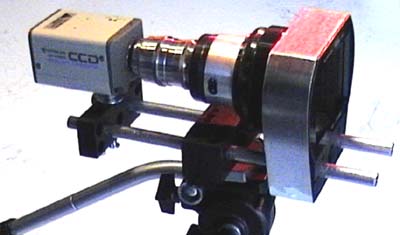Video Cameras
The basic idea is to build a camera out of the basic components like you have in a film camera. In a film camera you have the body, the lens, and the film. On a component video camera you respectively the CCD camera, the lens, and the recorder. The advantages to using a modular system include (but are not limited to) the following:
- improved control over depth of field compared to prosumer cameras
- large selection of professional lenses
- easy replacement of damaged components, no need to replace entire camera
- upgrade individual complainants as means permit, could even upgrade the camera to high definition -when they become available
- get the parts and features you want with none of the hype
- capture better color sampling (depending on the camera and recorder)
Professional lenses
These are C-mount zoom lens. They will screw directly on the camera below. . Note that these are real cine lenses. They have actual mechanical control over functions like the iris (aperture) and focus.
Industrial Video Cameras
Hitachi HV-C20A 1/2" 3-CCD Color Camera 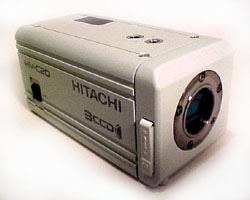 SPECIFICATIONS:
SPECIFICATIONS:
- Horizontal resolution: 700 Lines
- Color system: NTSC
- Optical system: 1/2" f1.4 prism
- Imaging system: 3-CCD RGB
- Imaging device: 3 1/2" interline transfer CCDs
- Integration Modes: Field or Frame, selectable
- Total number of pixels: 410,000 (811V x 508H)
- Effective number of pixels: 380,000 (768V x 494H)
- Sync system: Internal or Genlock
- Sensitivity: 2000 lux at f8
- Minimum illumination: 5.5 lux
- Gamma correction: 0.45 or 1.0 (Selectable)
- Preset Color Temperatures: 3200K and 5600K
- Lens Mount: Standard C-Mount
- Sensitivity selection: 0 to 18dB in 1 dB steps
- Electronic shutter: 1/100th - 1/250th - 1/500th - 1/1,1000th - 1/2,000 - 1/4000 - 1/10,000
- Color Bars: Full Bars
- OUTPUTS
- Composite: 1.0V p-p, 75 ohms
- Component: RGB, and Y/C
- Sync: HD, VD
- Supply Voltage: 12VDC
- Power Consumption: 4.5 Watts
This camera is typical of industrial use cameras. To find them on the internet or auction sites use the key words 3 ccd and c-mount video camera You will note that the specifications on this camera are fairly good much better than many prosumer cameras. This particular camera sold for about $250 on ebay. This camera has rgb and composite out but other cameras may have fire wire out. Look around for the features you want.
Recording device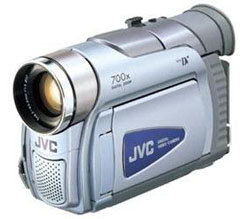
The little camera cam-corder pictured left can act as a recorder. It has composite, s-video, and firewire video capture. It is also a very affordable camera. New it can go for around $400. but used it can sell for $100. If it is used only as a recorder you can but a camera that has bad optics or a bad chip and get a great deal.
A dedicated mini-dv recorder could also be purchased but at a higher price
For Example:
The first two photos are of owyheesound's first prototype modular video camera. The Hitachi camera is only a single chip unit, but it is a 1/2" chip. This was a very affordable camera. And was purchased to

expedite experimentation instead of waiting to purchase a 3 chip camera. However, it was expected that this system would still outperform a standard consumer camera. And it does. Not pictured is the recorder which, in this case, is the JVC grd-70. The one pictured above. The modular camera unit send a signal to the JVC unit through a Y-C cable. There the JVC camera digitizes the signal and records it to mini-dv tape.
This is a prototype that serves as a camera to experiment with and test out functionality and performance. The Hardware pictured is owyheesound's standard angle iron beefed up erector set building set. This set up is too flimsy to use in the field but once a system is deemed operational then a more robust rail system will be built for this camera.
The photo to the right clearly shows how "manual" this camera is. Hard physical switches and knobs instead of the menu systems found on most consumer and even prosumer video cameras. Though not clearly visible the lens, a Tamron TV lens, has manual focus, and zoom to which follow focus attachment can be applied. The iris is also hand manual. You can actually grab the second nearest control ring on the lens to the camera to adjust the diaphragm's opening. The control ring closest to the camera is an extra bonus on this particular lens. It is a macro adjustment for focusing on subjects mere millimeters away from the front of the lens.
For an example of a real tricked out custom modular camera check out Dan Vance's Vancecam.

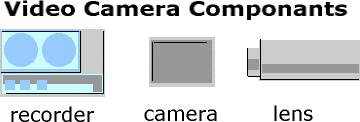
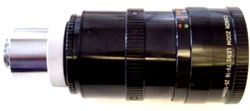
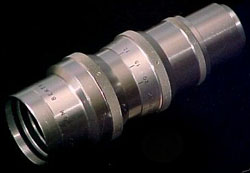
 SPECIFICATIONS:
SPECIFICATIONS: 

 expedite experimentation instead of waiting to purchase a 3 chip camera. However, it was expected that this system would still outperform a standard consumer camera. And it does. Not pictured is the recorder which, in this case, is the JVC grd-70. The one pictured above. The modular camera unit send a signal to the JVC unit through a Y-C cable. There the JVC camera digitizes the signal and records it to mini-dv tape.
expedite experimentation instead of waiting to purchase a 3 chip camera. However, it was expected that this system would still outperform a standard consumer camera. And it does. Not pictured is the recorder which, in this case, is the JVC grd-70. The one pictured above. The modular camera unit send a signal to the JVC unit through a Y-C cable. There the JVC camera digitizes the signal and records it to mini-dv tape.
